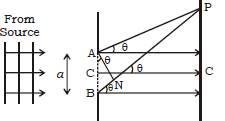 Long Answer Type
Long Answer Type(a) Draw a labelled diagram of a moving coil galvanometer. Describe briefly its principle and working.
(b) Answer the following:
(i) Why is it necessary to introduce a cylindrical soft iron core inside the coil of a galvanometer?
(ii) Increasing the current sensitivity of a galvanometer may not necessarily increase its voltage sensitivity. Explain, giving reason.
(a) In Young's double slit experiment, describe briefly how bright and dark fringes are obtained on the screen kept in front of a double slit. Hence obtain the expression for the fringe width.
(b) The ratio of the intensities at minima to the maxima in the Young's double slit experiment is 9: 25. Find the ratio of the widths of the two slits.
(a) Describe briefly how a diffraction pattern is obtained on a screen due to a single narrow slit illuminated by a monochromatic source of light. Hence obtain the conditions for the angular width of secondary maxima and secondary minima.
(b) Two wavelengths of sodium light of 590 nm and 596 nm are used in turn to study the diffraction taking place at a single slit of aperture 2 × 10−6 m. The distance between the slit and the screen is 1·5 m. Calculate the separation between the positions of first maxima of the diffraction pattern obtained in the two cases.
a) Diffraction of light at a Single slit
A single narrow slit is illuminated by a monochromatic source of light. The diffraction pattern is obtained on the screen placed in front of the slits. There is a central bright region called as central maximum. All the waves reaching this region are in phase hence the intensity is maximum. On both side of central maximum, there are alternate dark and bright regions, the intensity becoming weaker away from the center. The intensity at any point P on the screen depends on the path difference between the waves arising from different parts of the wave-front at the slit.
According to the figure, the path difference (BP – AP) between the two edges of the slit can be calculated.
Path difference, BP – AP = NQ = a sin 
Angle  is zero at the central point C on the screen, therefore all path differences are zero and hence all the parts of the slit are in phase. Due to this, the intensity at C is maximum. If this path difference is, (the wavelength of light used), then P will be the point of minimum intensity. This is because the whole wavefront can be considered to be divided into two equal halves CA and CB and if the path difference between the secondary waves from A and B is, then the path difference between the secondary waves from A and C reaching P will be
is zero at the central point C on the screen, therefore all path differences are zero and hence all the parts of the slit are in phase. Due to this, the intensity at C is maximum. If this path difference is, (the wavelength of light used), then P will be the point of minimum intensity. This is because the whole wavefront can be considered to be divided into two equal halves CA and CB and if the path difference between the secondary waves from A and B is, then the path difference between the secondary waves from A and C reaching P will be  /2, and path difference between the secondary waves from B and C reaching P will again be
/2, and path difference between the secondary waves from B and C reaching P will again be  /2. Also, for every point in the upper half AC, there is a corresponding point in the lower half CB for which the path difference between the secondary waves, reaching P is
/2. Also, for every point in the upper half AC, there is a corresponding point in the lower half CB for which the path difference between the secondary waves, reaching P is  /2. Thus, destructive interference takes place at P, and therefore, P is a point of first secondary minimum.
/2. Thus, destructive interference takes place at P, and therefore, P is a point of first secondary minimum.
Width of secondary maximum is given by, 
Width of secondary minima is given by, 
Since angular width is independent of n, all secondary minima and maxima are of the same width.
b) Given,
Aperture of the slit, a = 2 10 -6 m
Distance between slit and screen = 1.5 m
Therefore, linear separation, between the first maxima (n=1) of the two wavelengths, on the screen, is given by,

Therefore, separation is given by, 
